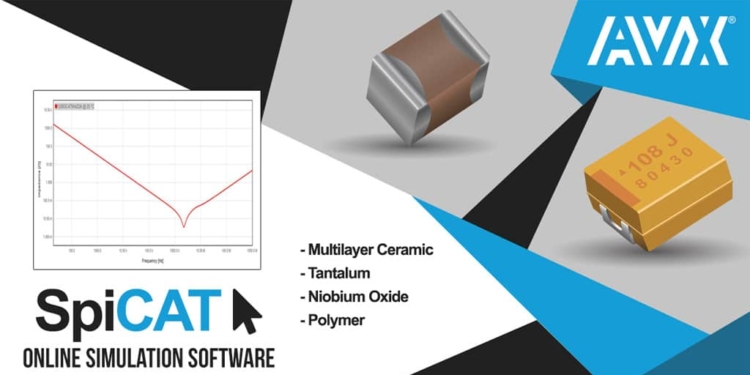Source: AVX news
Designed with users in mind, the new SpiCAT simulation software, which supersedes both SpiCap III & SpiTan IV, provides electrical & performance characteristics by frequency & temperature for an extensive range of part numbers & offers several new features to support quick, easy, & accurate parametric characterization.
FOUNTAIN INN, S.C. (July 12, 2018) – AVX Corporation, a leading manufacturer and supplier of advanced electronic components and interconnect, sensor, control, and antenna solutions, released the new SpiCAT online simulation tool. Designed with users in mind, new SpiCAT simulation software offers access to two separate portals — SpiMLCC and SpiTAN, which supersede SpiCap III and SpiTan IV — that provide electrical and performance characteristics by frequency and temperature for an extensive range of multilayer ceramic or tantalum, polymer, and niobium oxide surface-mount capacitors. The new SpiCAT software also simplifies capacitor selection, grouping different product series by common application features, and allows design engineers to review electrical characteristics for individual part numbers with respect to temperature and frequency to support quick, easy, and accurate parametric characterization and the rapid identification of capacitor solutions that are ideally suited to their individual application requirements.
The updated software also offers enhanced functionality. Once a part has been selected, interactive graphs allow users to identify the effect that modified frequencies and temperatures have on parameters including capacitance, equivalent series resistance (ESR), dissipation factor (DF), impedance, ripple voltage, and ripple current. The program also allows users to input application voltage and temperature information to chart direct current leakage (DCL) over time, provides an equivalent circuit diagram with characteristics for each parameter. Other new features allow users download 3D models of each case size, print out graphs and parameters for selected part numbers, and check inventory in distributor stock.
“AVX is continuously working to improve our customers’ experience, and our newly redesigned SpiCAT simulation software does just that,” said Mitch Weaver, member of the technical staff, AVX. “We’re very proud to share our responsive, new SpiCAT software and to better support our customers’ design programs by providing quick, easy, and accurate parametric characterization for an extensive range of surface-mount MLCC, tantalum, polymer, and niobium oxide capacitors.”
For more information about SpiCAT, please visit https://spicat.avx.com/ to access the new SpiCAT – SpiMLCC and SpiCAT – SpiTAN interactive simulation tools for multilayer ceramic, tantalum, polymer, and niobium oxide capacitors.


































